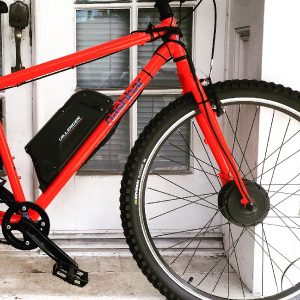Electric assist bikes (e-bikes) are fun to ride in cold, snowy, or wet weather. However, just like a standard bicycle, you may need some accessories (like rain gear or studded tires for winter) for comfort and safety. Most e-bike models also provide a high-quality, water-resistant casing to protect your battery when wet and cold. You can ride an e-bike at any temperature, but the colder it is, the more it may impact the battery’s range. So bring your battery (or the entire bike + battery) inside if you’re not riding it, if possible.
Riding an e-bike in cold weather

STAYING DRY WHILE RIDING IN THE RAIN
An electric bike’s system, including the motor, battery pack, display, and connection points, is usually designed with closed units to accommodate wet weather. This protects the electrical system from getting wet while riding in the rain. The critical distinction here is that e-bikes are water-resistant but not waterproof. So, for this reason, it’s a good idea to avoid heavily flooded roads, streams, and deep puddles that could submerge your bike’s electrical components.
As electric bikes might have different limitations, you may need to refer to your owner’s manual or check with your manufacturer for the IP rating of your bike first. If you live in an area that experiences frequent wet weather, you’ll want to make water resistance a top factor in your purchase decision.
Riding an e-bike with ice and snow conditions

Riding an e-bike fatty in inclement weather is fun
Yes, you can ride your e-bike in the winter. However, riding in extreme cold, snow, and icy conditions will require more maintenance, protection, and care. With advancements in tire technology and clothing warmth, there are fewer reasons not to take your electric bicycle out and enjoy the winter season. All e-bikes can handle winter riding, but the wider the tire, the better, especially if studs can be installed on your bike’s tire for icy conditions. That said, you must follow the key points below to ensure you enjoy riding your bike during the winter.
Use the correct type of tire
Like a regular bike you might use for winter riding, the tires that come with your electric bicycle are great for most dry pavement riding, but not winter. Maneuvering a bike (with or without a motor) requires a tire that handles ice and snow. Then add studs to those winter tires, transforming your e-bike into a fantastic winter vehicle! Great for riding on plowed roads and for hard-packed or icy conditions. If you are looking at a fat tire e-bike for winter riding, ask the dealer if studs can be added to the tires on that bike.
Battery Care
-
A center post battery mount is common for many e-bike models
The general rule with a 36 volt, 10.5Ah (ampere-hours) battery should get 20 to 40 miles per charge with the average weight of rider + gear & cargo less than 200 pounds in ideal weather conditions. You’ll get fewer miles the higher the assist level you use. You might get 60 miles or more on a single charge on the low assist. To maximize the life of your e-bike battery, try to charge it when it’s near empty. Then, ride your e-bike a lot and charge it often.
Before charging, make sure your battery is in a room above freezing. Otherwise, you could harm the cells. It is no problem to ride the bike in below-freezing conditions (it doesn’t damage the battery). However, make sure you let the battery warm up slowly before charging. When riding an e-bike in very cold weather, you will notice a drop in power and range. Don’t worry; this is normal when riding an e-bike in the winter.
Knowing your e-bike’s battery life and performance in cold weather is good. If you intend to commute to work or use the bike for a backcountry experience, test it out to determine the change in range with colder temps. And the steps you would take to ensure continued performance. For instance, purchasing a neoprene e-bike battery cover might be an option. Also, if you stop midway on your journey to warm up, bring the battery inside whenever you aren’t riding. This will keep the battery’s temperature up and give you extra power!
Avoid riding through slush
Riding your electric bike through snow is not only possible, but it’s also super fun! (See the Pedego video below for proof) What’s not fun is riding through slush. The watery, salty snow splashes up your gears and can seep into hard-to-reach areas, causing rust to form. If you must ride through slush, wipe the entire bike down, lube the chain, etc. Afterward, try to store your bike in a warm, dry location.


